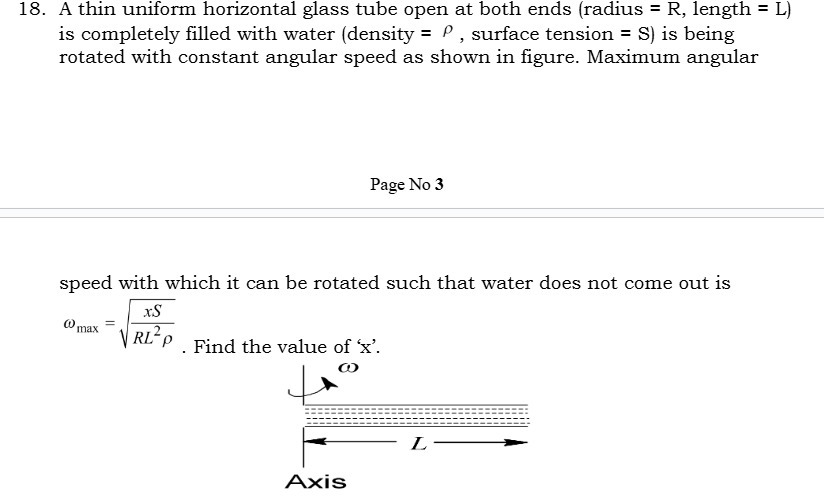Question
Question: A thin uniform horizontal glass tube open at both ends (radius = R, length = L) is completely filled...
A thin uniform horizontal glass tube open at both ends (radius = R, length = L) is completely filled with water (density = ρ, surface tension = S) is being rotated with constant angular speed as shown in figure. Maximum angular
Page No 3
speed with which it can be rotated such that water does not come out is ωmax=RL2ρxS. Find the value of 'x'.

8
Solution
The problem describes a thin uniform horizontal glass tube, open at both ends and completely filled with water, rotating with constant angular speed ω about an axis at one of its ends. The goal is to find the maximum angular speed ωmax such that water does not come out.
-
Pressure variation due to rotation: Consider a small element of water at a distance r from the axis of rotation. The centrifugal force acting on this element is dmω2r. This force creates a pressure gradient in the fluid. The pressure P(r) at a distance r from the axis of rotation is given by: dP=ρω2rdr Integrating this from the axis (r=0) to any point r: ∫P0PrdP=∫0rρω2rdr Pr−P0=21ρω2r2 Where P0 is the pressure at the axis of rotation (r=0). For the end of the tube at r=L, the pressure is PL: PL−P0=21ρω2L2 (Equation 1)
-
Pressure conditions at the ends due to surface tension: The tube is open at both ends. For water not to come out, the surface tension must be able to hold the water column.
- At the outer end (r=L): Water tends to be pushed out due to the centrifugal force. For water to stay in, the surface tension must exert an inward force. This means the meniscus formed at this end would be convex outwards. The maximum pressure difference that surface tension can sustain for a convex meniscus is R2S (assuming a hemispherical meniscus, where R is the radius of the tube). So, the pressure inside the tube at r=L, PL, can be at most Patm+R2S. PL=Patm+R2S (Equation 2)
- At the inner end (r=0): As water is pushed outwards from the outer end, it creates a suction effect at the inner end. For the water column to remain continuous and not break, the pressure inside the tube at r=0, P0, must be lower than the atmospheric pressure. The minimum pressure that surface tension can sustain for a concave meniscus (pulling water in) is Patm−R2S. P0=Patm−R2S (Equation 3)
-
Combining the conditions: Substitute Equation 2 and Equation 3 into Equation 1: (Patm+R2S)−(Patm−R2S)=21ρω2L2 Patm+R2S−Patm+R2S=21ρω2L2 R4S=21ρω2L2
-
Solving for ωmax: Now, we can solve for ω: ω2=R4S×ρL22 ω2=ρRL28S So, the maximum angular speed is: ωmax=ρRL28S
-
Finding the value of 'x': The given formula for ωmax is RL2ρxS. Comparing our derived formula with the given formula: RL2ρ8S=RL2ρxS Therefore, x=8.
The value of 'x' is 8.
